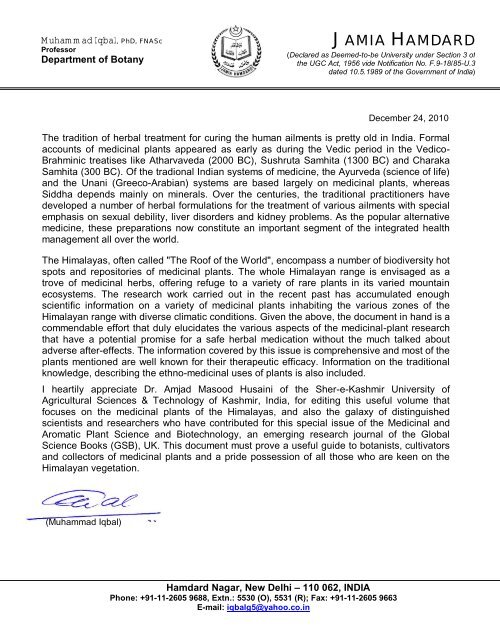Medicinal and Aromatic Plant Science and Biotechnology
Medicinal and Aromatic Plant Science and Biotechnology
Medicinal and Aromatic Plant Science and Biotechnology
You also want an ePaper? Increase the reach of your titles
YUMPU automatically turns print PDFs into web optimized ePapers that Google loves.
Muhammad Iqbal, PhD, FNASc<br />
Professor<br />
Department of Botany<br />
JAMIA HAMDARD<br />
(Declared as Deemed-to-be University under Section 3 of<br />
the UGC Act, 1956 vide Notification No. F.9-18/85-U.3<br />
dated 10.5.1989 of the Government of India)<br />
December 24, 2010<br />
The tradition of herbal treatment for curing the human ailments is pretty old in India. Formal<br />
accounts of medicinal plants appeared as early as during the Vedic period in the Vedico-<br />
Brahminic treatises like Atharvaveda (2000 BC), Sushruta Samhita (1300 BC) <strong>and</strong> Charaka<br />
Samhita (300 BC). Of the tradional Indian systems of medicine, the Ayurveda (science of life)<br />
<strong>and</strong> the Unani (Greeco-Arabian) systems are based largely on medicinal plants, whereas<br />
Siddha depends mainly on minerals. Over the centuries, the traditional practitioners have<br />
developed a number of herbal formulations for the treatment of various ailments with special<br />
emphasis on sexual debility, liver disorders <strong>and</strong> kidney problems. As the popular alternative<br />
medicine, these preparations now constitute an important segment of the integrated health<br />
management all over the world.<br />
The Himalayas, often called "The Roof of the World", encompass a number of biodiversity hot<br />
spots <strong>and</strong> repositories of medicinal plants. The whole Himalayan range is envisaged as a<br />
trove of medicinal herbs, offering refuge to a variety of rare plants in its varied mountain<br />
ecosystems. The research work carried out in the recent past has accumulated enough<br />
scientific information on a variety of medicinal plants inhabiting the various zones of the<br />
Himalayan range with diverse climatic conditions. Given the above, the document in h<strong>and</strong> is a<br />
commendable effort that duly elucidates the various aspects of the medicinal-plant research<br />
that have a potential promise for a safe herbal medication without the much talked about<br />
adverse after-effects. The information covered by this issue is comprehensive <strong>and</strong> most of the<br />
plants mentioned are well known for their therapeutic efficacy. Information on the traditional<br />
knowledge, describing the ethno-medicinal uses of plants is also included.<br />
I heartily appreciate Dr. Amjad Masood Husaini of the Sher-e-Kashmir University of<br />
Agricultural <strong>Science</strong>s & Technology of Kashmir, India, for editing this useful volume that<br />
focuses on the medicinal plants of the Himalayas, <strong>and</strong> also the galaxy of distinguished<br />
scientists <strong>and</strong> researchers who have contributed for this special issue of the <strong>Medicinal</strong> <strong>and</strong><br />
<strong>Aromatic</strong> <strong>Plant</strong> <strong>Science</strong> <strong>and</strong> <strong>Biotechnology</strong>, an emerging research journal of the Global<br />
<strong>Science</strong> Books (GSB), UK. This document must prove a useful guide to botanists, cultivators<br />
<strong>and</strong> collectors of medicinal plants <strong>and</strong> a pride possession of all those who are keen on the<br />
Himalayan vegetation.<br />
(Muhammad Iqbal)<br />
Hamdard Nagar, New Delhi – 110 062, INDIA<br />
Phone: +91-11-2605 9688, Extn.: 5530 (O), 5531 (R); Fax: +91-11-2605 9663<br />
E-mail: iqbalg5@yahoo.co.in
















